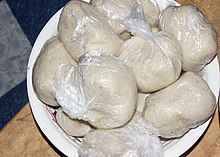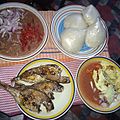Banku (dish): Difference between revisions
Citation bot (talk | contribs) Alter: url. URLs might have been anonymized. Add: authors 1-1. Removed parameters. Some additions/deletions were parameter name changes. | Use this bot. Report bugs. | Suggested by AManWithNoPlan | #UCB_CommandLine |
cap, punctuation, syntax and markup corrections Tags: Mobile edit Mobile app edit iOS app edit |
||
| Line 15: | Line 15: | ||
|module = {{Center|{{Listen|embed=yes|filename=Tw.Banku.ogg|title=Pronunciation of Banku|type=speech|description=recorded October 2021}}}} |
|module = {{Center|{{Listen|embed=yes|filename=Tw.Banku.ogg|title=Pronunciation of Banku|type=speech|description=recorded October 2021}}}} |
||
}} |
}} |
||
In [[Ghana]] cuisine, ''' |
In [[Ghana]]ian cuisine, '''banku''' ({{IPAc-en|audio=Tw-Banku.ogg}}) is a slightly [[Fermentation|fermented]] cooked mixture of corn and [[cassava]] doughs formed into single-serving balls. |
||
Banku is different from any other '' |
Banku is different from any other ''akple'' product forms [[Indigenous peoples|indigenous]] to the [[Ewe people|Ewes]].<ref>(1) A Grammatical Sketch of the Akra or Ga-language - By Johannes Zimmermann, (2) Online Reference By J DZeagu-Kudjodji and Others.</ref> It is a [[Ghanaian]] dish of GaDangme (or Ga) origin, which is a mixture of fermented [[Maize|corn]] and [[cassava]] [[dough]] that has been cooked in hot water until it turns into a smooth, whitish paste,<ref name="Haard" /><ref name="TBTG">{{cite book | last1=Briggs | first1=P. | last2=Rushton | first2=K. | title=Ghana: The Bradt Travel Guide | publisher=Bradt Travel Guides | series=Bradt Guides | year=2007 | isbn=978-1-84162-205-7 | url=https://archive.org/details/ghana0000brig | url-access=registration | page=[https://archive.org/details/ghana0000brig/page/73 73]}}</ref><ref>{{Cite web|last=Muyambo|first=Freda|date=2019-06-25|title=Banku|url=https://www.196flavors.com/ghana-banku/|access-date=2021-05-15|website=196 flavors|language=en-US}}</ref> served with [[soup]], [[Okra soup|okra]] stew or a pepper [[sauce]] with fish.<ref>online reference, by J Dzeagu-Kudjodji and others ;{{cite web|title=Banku|url=http://www.ghanaweb.com/GhanaHomePage/food/banku.html|access-date=14 February 2015}}</ref><ref>{{Cite web|date=13 December 2017|title=How to prepare Banku|url=https://www.ghanaweb.com/GhanaHomePage/food/How-to-prepare-banku-609361|website=Ghana Web}}</ref> |
||
It is preferred by the people of the Southern Regions of Ghana; the [[Ewe people]], the [[Fante people]] and the [[Ga-Adangbe people]] but also eaten across other regions in [[Ghana]]. The [[Ga–Dangme people|GaDangme]] (or Ga) people have a softer variation of the food which they call Banku, while the Fante people have a drier variant of the dish they call ''ɛtsew''.<ref name="Haard">{{cite book | last=Haard | first=N.F. | title=Fermented Cereals: A Global Perspective | publisher=Food and Agriculture Organization of the United Nations | series=FAO agricultural services bulletin | issue=138 | year=1999 | isbn=978-92-5-104296-0 | url=https://books.google.com/books?id=PtqY7dP7Ib0C&pg=PA37 | page=37}}</ref><ref name="TBTG" /><ref>{{cite web|title=Banku|url=http://ifood.tv/dough/banku/about|website=ifood.tv/|publisher=Future Today Inc|access-date=14 February 2015}}</ref> |
It is preferred by the people of the Southern Regions of Ghana; the [[Ewe people]], the [[Fante people]] and the [[Ga-Adangbe people]] but also eaten across other regions in [[Ghana]]. The [[Ga–Dangme people|GaDangme]] (or Ga) people have a softer variation of the food which they call Banku, while the Fante people have a drier variant of the dish they call ''ɛtsew''.<ref name="Haard">{{cite book | last=Haard | first=N.F. | title=Fermented Cereals: A Global Perspective | publisher=Food and Agriculture Organization of the United Nations | series=FAO agricultural services bulletin | issue=138 | year=1999 | isbn=978-92-5-104296-0 | url=https://books.google.com/books?id=PtqY7dP7Ib0C&pg=PA37 | page=37}}</ref><ref name="TBTG" /><ref>{{cite web|title=Banku|url=http://ifood.tv/dough/banku/about|website=ifood.tv/|publisher=Future Today Inc|access-date=14 February 2015}}</ref> |
||
Revision as of 14:28, 21 August 2022
This article may require copy editing for grammar, style, cohesion, tone, or spelling. (June 2022) |
 Balls of banku | |
| Alternative names | akume, ɛtsew |
|---|---|
| Type | Swallow |
| Place of origin | Ghana |
| Serving temperature | Hot |
| Main ingredients | Corn dough, cassava dough, salt and water |
In Ghanaian cuisine, banku (// ) is a slightly fermented cooked mixture of corn and cassava doughs formed into single-serving balls.
Banku is different from any other akple product forms indigenous to the Ewes.[1] It is a Ghanaian dish of GaDangme (or Ga) origin, which is a mixture of fermented corn and cassava dough that has been cooked in hot water until it turns into a smooth, whitish paste,[2][3][4] served with soup, okra stew or a pepper sauce with fish.[5][6]
It is preferred by the people of the Southern Regions of Ghana; the Ewe people, the Fante people and the Ga-Adangbe people but also eaten across other regions in Ghana. The GaDangme (or Ga) people have a softer variation of the food which they call Banku, while the Fante people have a drier variant of the dish they call ɛtsew.[2][3][7]
Etymology
It is a distinctively Ga-Dangme term.[8][citation needed] There are similar tonal terms with different meaning in the Ga-language, such as Inku (for pomade in the Ga-language), Ashanku (for a variant of a plantain fritter called 'Tatale' in the Ga-language), and many other names ending in 'Ku'.[9][citation needed]
Ingredients
The main ingredients for preparing Banku are corn flour, cassava dough, salt and water, as distinguished in the akple products preparation. Banku and akple product forms are different yet similar in appearance as dumplings.[10][11] They are traditionally eaten with hands.[12] Akple is usually eaten with an Okro soup known as "Fetri Detsi" among the Ewes.[13]
Preparation
This section contains instructions, advice, or how-to content. (June 2022) |
Preparation of the dough takes time. Cassava is peeled, chopped and mixed with corn grains and soaked for a day. The water is poured off and the cassava and maize is milled into a smooth, fine and wet dough. The next stage in the preparation process is the fermentation of the dough. This takes between two and five days depending on climatic temperatures.[14][15]
Then, the corn and cassava dough are mixed with at least 500ml of water in a deep stainless steel saucepan. The mixture is then put over a medium flame and stirred until the slurry begins to boil. The mixture is stirred gradually until the slurry becomes dough-like. Using a wooden spatula the dough is kneaded until it is smooth. When smooth, any dough stuck to the sides of the pan is removed and centered into the dough.
Water is added around the "dough-in-pan-island", enough to almost cover the surface. It then needs to be covered well and allowed to boil, ensuring even cooking and steaming of the dough in the covered pan. Next, the dough is kneaded with a spatula to incorporate the water into it until it is smooth. The process is repeated with centering, watering, and kneading until the dough is soft and evenly cooked. Using a small bowl the Banku is portioned into a bowl. The process continues until there is no more Banku left in the saucepan. It can be served with soup, stew or pepper with meat or fish.[16]
Gallery
-
Akple
-
Banku and pepper
-
Grilled tilapia with Bbnku
-
Banku with okro stew and crab
-
Banku with fried fish and hot pepper
-
A ball of akple tied in a rubber
-
Akple (upper-right) and borbi tadi
-
A woman preparing banku in Ghana
-
Preparing banku
References
- ^ (1) A Grammatical Sketch of the Akra or Ga-language - By Johannes Zimmermann, (2) Online Reference By J DZeagu-Kudjodji and Others.
- ^ a b Haard, N.F. (1999). Fermented Cereals: A Global Perspective. FAO agricultural services bulletin. Food and Agriculture Organization of the United Nations. p. 37. ISBN 978-92-5-104296-0.
- ^ a b Briggs, P.; Rushton, K. (2007). Ghana: The Bradt Travel Guide. Bradt Guides. Bradt Travel Guides. p. 73. ISBN 978-1-84162-205-7.
- ^ Muyambo, Freda (2019-06-25). "Banku". 196 flavors. Retrieved 2021-05-15.
- ^ online reference, by J Dzeagu-Kudjodji and others ;"Banku". Retrieved 14 February 2015.
- ^ "How to prepare Banku". Ghana Web. 13 December 2017.
- ^ "Banku". ifood.tv/. Future Today Inc. Retrieved 14 February 2015.
- ^ "AFRICA | 101 Last Tribes - Ga people". www.101lasttribes.com. Retrieved 2022-08-12.
- ^ Mensah, Joseph Nii Abekar (2013). Traditions and Customs of Gadangmes of Ghana: Descendants of Authentic Biblical Hebrew Israelites. Strategic Book Publishing. ISBN 978-1-62857-104-2.
- ^ Annan, Dorcas Aba. "Akple & Ground Pepper with Grilled Tilapia". Archived from the original on 14 February 2015. Retrieved 14 February 2015.
- ^ Briggs, P. (2014). Ghana. Bradt Travel Guide Ghana. Bradt Travel Guides. p. 84. ISBN 978-1-84162-478-5.
- ^ Edwards, E.; Gosden, C.; Phillips, R. (2006). Sensible Objects: Colonialism, Museums and Material Culture. Wenner-Gren International Symposium Series. Bloomsbury Publishing. p. 50. ISBN 978-1-84788-315-5.
- ^ "Ghana: Okro Stew". 196 flavors. 2019-06-26. Retrieved 2020-03-09.
- ^ "Ghana: Banku". 196 flavors. 2019-06-25. Retrieved 2020-06-01.
- ^ Gracia, Zindzy (2018-03-01). "How to prepare banku". Yen.com.gh - Ghana news. Retrieved 2021-10-09.
- ^ Gracia, Zindzy (2018-03-01). "How to prepare banku". Yen.com.gh - Ghana news. Retrieved 2021-05-15.









